
Sringeri also called Shringeri is a hill town and Taluk headquarters located in Chikkamagaluru district in the Indian state of Karnataka. It is the site of the first maṭha established by Ādi Shankarāchārya, Hindu theologian and exponent of the Advaita Vedanta philosophy. Located on the banks of the river Tungā, the town draws a large number of pilgrims to its temples of Sri Sharadamba, Sri Vidyashankara, Sri Malahanikareshvara and other deities.
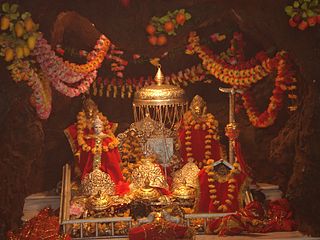
Vaishno Devi is a manifestation of the Hindu mother goddess Durga in some beliefs while in some beliefs she is a manifestation of goddess Lakshmi. Vaishno Devi is worshipped as a combined avatar of the goddesses Mahakali, Mahalakshmi, and Mahasarasvati.

The Tungabhadra River starts and flows through the state of Karnataka, India, during most of its course, then through Andhra Pradesh, and ultimately joins the Krishna River near Murvakonda in Andhra Pradesh.

Dakṣiṇāmnāya Śrī Śāradā Pīṭham or Śri Śṛṅgagiri Maṭha ; Sanskrit: मठ, maṭha) is one amongst the four cardinal pīthams following the Daśanāmi Sampradaya - the peetham or matha is said to have been established by acharya Śrī Ādi Śaṅkara to preserve and propagate Sanātana Dharma and Advaita Vedānta, the doctrine of non-dualism. Located in Śringerī in Chikmagalur district in Karnataka, India, it is the Southern Āmnāya Pītham amongst the four Chaturāmnāya Pīthams, with the others being the Dvārakā Śāradā Pītham (Gujarat) in the West, Purī Govardhana Pīṭhaṃ (Odisha) in the East, Badri Jyotishpīṭhaṃ (Uttarakhand) in the North. The head of the matha is called Shankarayacharya, the title derives from Adi Shankara.

The ChottanikkaraDevi Temple is a temple dedicated to the Hindu mother goddess Bhagavati Lakshmi. She is believed to be residing in Chottanikkara (Mahalakshmi) along with her Husband Maha Vishnu. The main deity is also considered as Lakshmi Narayana according to the temple legend. The temple is Classified one among the 108 Abhimana Kshethram of Vaishnavate tradition. The temple is located at Chottanikkara, a southern suburb of the city of Kochi in Ernakulam district, in the state of Kerala, India and is one of the most popular temples in the state.
Prabhas Patan, historically named Dev Patan, is a locality in Veraval, Gujarat. As the site of the Somnath temple and its associated Jyotirlinga, it is an important place of Hindu pilgrimage.

Mahur or Mahurgad is a town and religious place in Nanded district of Maharashtra, India. Mahur is the birthplace of Hindu God Dattatreya. Dattatreya parents Atri Rishi and Sati Anasuya Mata lived here. Brahmadev, Vishnudev and Lord Shiva once got a news about Anusaya Mata that there is no one more pious and pure as her. To test her piousness they arrived under the garb of asking Alm (bhiksha). Near Mahur, There is a Pious confluence of River Penganga and River Pus at Hiwara Sangam village, Tal. Mahagaon Vidarbha, from where the river flows northward. Penganga river forms a border between Vidarbha and Marathwada. Mahur falls just about 3kms inside Marathwada due to river banks.

Avani is a small village in Mulabaagilu taluk, Kolara district in Karnataka, India, about ten miles from Kolar Gold Fields. The village is located at 32 km from Kolara, the district centre and 13 km from Mulabaagilu, the Taluk headquarters. It is a popular location for rock climbing.
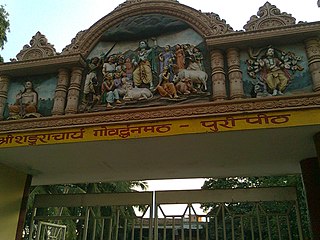
Purvamnaya Sri Govardhana Pitham or Govardhan Math is one amongst the four cardinal pithams established by the philosopher-saint Adi Shankara to preserve and propagate Hinduism and Advaita Vedanta, the doctrine of non-dualism. Located in Puri in Odisha, India, it is the Eastern Āmnāya Pītham amongst the four pithams, with the others being the Sringeri Śārada Pīṭhaṃ (Karnataka) in the South, Dvārakā Śāradā Pītham (Gujarat) in the West, Badari Jyotirmaṭha Pīṭhaṃ (Uttarakhand) in the North .It is associated with the Jagannath temple. Their Vedantic mantra or Mahavakya is Prajñānam brahma and as per the tradition initiated by Adi Shankara it holds authority over the Rigveda. The head of the matha is called Shankarayacharya, the title derives from Adi Shankara.
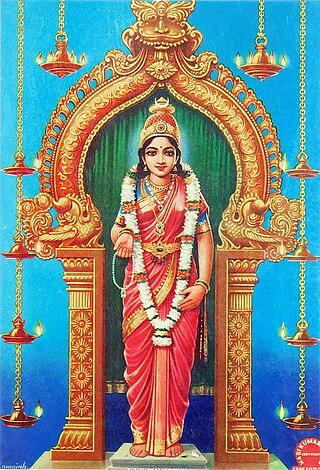
Devi Kanya Kumari is a manifestation of the Hindu goddess Mahadevi in the form of an adolescent girl. She is variously described by various traditions of Hinduism to either be a form of Parvati or Lakshmi. She is also worshipped as an incarnation of the goddess Bhadrakali by Shaktas, and is known by several names such as Shrī Bāla Bhadra, Shrī Bāla, Kanya Devi, and Devi Kumari.
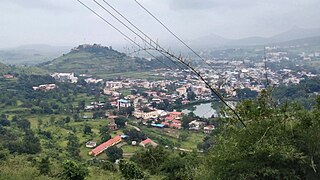
Trimbak is a city and a municipal council in Nashik District in the Indian state of Maharashtra. The Trimbakeshwar Shiva Temple is located here, one of the twelve Jyotirlingas, where the Hindu genealogy registers at Trimbakeshwar, Maharashtra are kept. The origin of the sacred Godavari River is near Trimbak.

Saptashrungi or Saptashringi is a site of Hindu pilgrimage situated 60 kilometres (37 mi) from Nashik in Indian state of Maharashtra. According to Hindu traditions, the goddess Saptashrungi Nivasini dwells within the seven mountain peaks. It is located in Nanduri, Kalwan taluka, a small village near Nashik in India. The Marathas and some Hindu tribes have worshipped the goddess from a long time and some worship her as their kuldaivat. There are 510 steps to climb the gad. To go from below to the temple, the temple trust has also provided the facility of a furnacular trolley. Its work started in July 2018. There are a total of 6 coaches in this trolley, and 10 passengers can sit in one coach. This trolley takes 3 minutes to reach the temple. Passengers have to climb 20 to 25 stairs to go from the station above the trolley to the temple. This trolley carries about 5000 passengers every day. Devotees visit this place in large numbers every day. The temple is also known popularly as one of the "three and half Shakta pithas" of Maharashtra. The temple is also one among the 51 Shakta pithas located on the Indian subcontinent and is a location where one of Sati's limbs, her right arm is reported to have fallen. Its half shaktipeeth among three and half shaktipeeth of Maharashtra.

Thirumandhamkunnu Temple is a historically significant Hindu temple in Angadipuram, which was the capital of Valluvanad Rajavamsham, in Malappuram district, Kerala state, South India. The temple deity, Thirumandhamkunnil amma, was the paradevatha of the kings of Valluvanad, the local feudal kings ruled the area in the Middle Ages. The Nair warriors of Valluvanad king set out from this temple to Thirunavaya, to participate in the famous Mamankam festival. A memorial structure called the chaver thara can be found in front of the main entrance of the Thirumanthamkunnu Temple.

Sri Sharadamba Temple is a famous Hindu temple dedicated to goddess Sharadamba in the holy town of Sringeri in Karnataka, India. It is located next to the Tunga river.
Hariharapura is a village located in the Koppa Taluk, Chikkamagaluru district district in the state of Karnataka, India. The place has a Matt(Hindu Temple) of goddess Sharadamba on the banks of the River Tunga. The place is serene amidst forest, Arecanut farms and rice fields and surrounded by small hills. It is believed that Daksha performed "yagna" here.

The Vithoba Temple, officially known as Shri Vitthal-Rukmini Mandir, is a Hindu temple in Pandharpur, in the Indian state of Maharashtra. It is the main centre of worship for Vithoba, a form of the god Vishnu or Krishna, and his consort Rakhumai. It is one of the 108 Abhimana Kshethram of Vaishnavate tradition. The temple was built by King Vishnuvardhana of Hoysala Empire between 1108 and 1152 CE upon being convinced by the historical figure Pundalik. Also, there is an inscription in the temple, of a Hoysala King Vira Someshwara dating back to 1237 CE, which grants the temple a village for its upkeep. It is the most visited temple in Maharashtra. The Warkaris start marching from their homes to the temple of Pandharpur in groups called Dindi (procession) to reach on Aashadhi Ekadashi and Kartiki Ekadashi. A dip in the holy river Chandrabhaga, on whose banks Pandharpur resides, is believed to have power to wash all sins. All the devotees are allowed to touch the feet of the idol of Vithoba. In May 2014, the temple became the first in India to invite women and people from backward classes as priests.

The Advaita Guru-Paramparā is the traditional lineage (parampara) of divine, Vedic and historical teachers of Advaita Vedanta. It begins with the Daiva-paramparā, the gods; followed by the Ṛṣi-paramparā, the Vedic seers; and then the Mānava-paramparā, with the historical teachers Gaudapada and Adi Shankara, and four of Shankara's pupils. Of the five contemporary acharyas, the heads of the five Advaita mathas, four acharyas trace their lineage to those four pupils and one to Adi Shankara himself.

Uttarāmnāya Śrī Jyotish Pītham or JyotirMath is one amongst the four cardinal pīthams established by the Ādi Śaṅkara 1300 years ago to preserve Hinduism and Advaita Vedānta, the doctrine of non-dualism. Located in the city of Joshimath, Chamoli district, Uttarakhand, India, it is the uttarāmnāya matha or Northern Āmnāya Pītham, amongst the four Chaturamnay Peethams - Kalady Kerala, birthplace of Adi Shankara with the others being the Sringeri Śārada Pīṭhaṃ (Karnataka) in the South, Dvārakā Śāradā Pītham in the West and Purī Govardhanmaṭha Pīṭhaṃ in the east. Its appointees bear the title of Shankaracharya. It is the headquarters of Giri, Parvata & Sagara sects of the Dasnami Sampradaya. Their Vedantic mantra or Mahavakya is Ayamātmānam brahma and as per the tradition initiated by Adi Shankara it holds authority over Atharva Veda. The head of the matha is called Shankaracharya, the title derives from Adi Shankara.

Ramachandrapura Math (monastery) is a Hindu monastery located in Hosanagara taluk of Shimoga, Karnataka. The Matha is followed mainly by the Havyaka Brahmins in Uttara Kannada, Dakshina Kannada, Udupi, Shimoga districts of Karnataka and Kasaragod district of Kerala. It was established by Adi Shankaracharya originally near Gokarna, a holy town on the west coast of India. The matha was initially known as Raghuthama Matha. The Swami of the matha is a celibate (brahmacharya) and a Havyaka by birth. He adds the title Bharati to his name. The present guru is Jagadguru Shankaracharya Shri Raghaveshwara Bharathi MahaSwamiji. He was initiated sanyasa by his guru Jagadguru Shankaracharya shri Ragavendra Bharati mahaswamiji the 35th Pontiff of Shri Ramachandrapura Mutt.
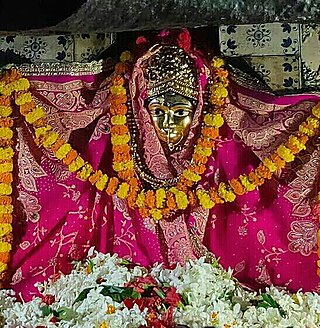
Maa Tara Chandi Temple is a Hindu temple dedicated to Maa Shakti or Maa Durga, located in Sasaram, Bihar, India. It is one of the 51 Shakti Peetha.




















